|
The
Abbey Lawn
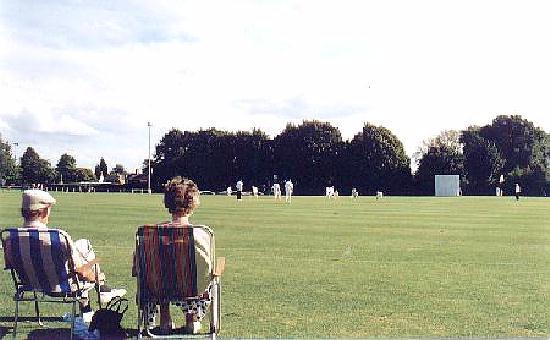
Saturday afternoon cricket on the Abbey Lawn pitch.
Bourne is blessed with
green spaces for relaxation and leisure including the recreation ground and the Wellhead Gardens
but the main venue for sporting activities has for many years been the Abbey Lawn,
an open space endowed by an ancient charity and providing facilities for a wide variety of
games for both the beginner and the veteran.
The land originally formed part of the grounds of Bourne Abbey but the
public were allowed to use it at the discretion of the vicar. There is no record
of the public ever being banned from using the Abbey Lawn for this purpose and
so it became the town's unofficial recreation ground and has been in use for
such purposes for at least 200 years. The land was eventually acquired by a
syndicate of local businessmen who rented out the rights for cricket and
football but when it was under
threat from housing development, Bourne United Charities decided to buy it
for the benefit of the town.
The Charity Commissioners were approached
and in January 1931 the purchase was sanctioned subject to a satisfactory
valuation and by May that year, the transaction was agreed in the sum of
£700, to which the cricket club, one of
the main users, made a token donation of £20. The trustees made the
purchase with the intention of preserving it as an open space and sports ground for the town in
perpetuity and since then there has been a continuous programme of improvement and
upkeep for both the sports playing areas and the outdoor swimming pool
which is part of the complex.
A
plaque on the left hand column at the main gate says: "These grounds were purchased in the
years 1931-34 by the Trustees of Bourne United Charities in order to
preserve the same as an open space for ever and the work of levelling and
laying out the grounds was carried out by trainees from the Ministry of
Labour Instructional Centre, Bourne." There is a second notice on the
opposite column that says: "The trees and shrubs in these grounds
were planted to commemorate the Silver Jubilee of HM King George the
Fifth, 6th May 1935."
|
A plaque on the main gate in Abbey Road,
erected in 1934, states that the Abbey Lawn should be preserved as
an open space for ever and the promise is still honoured today.. |
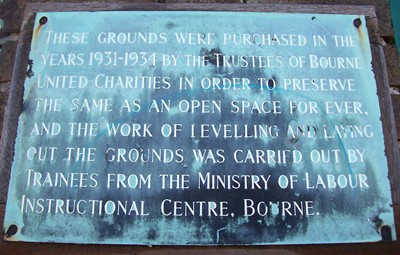 |
The Abbey Lawn has also become one of the most attractive cricket grounds in Lincolnshire and home to the Bourne Town Cricket Club. Their activities date from 1803 but current records only go back to 1920 and although their home matches have always been played on this ground, the facilities have become greatly enhanced under the present ownership.
Bourne Tennis Club is also based here and there was once a putting green (circa 1965) but now closed. It was a
great attraction during the summer months when visitors could spend an
enjoyable hour or so for 3d. a round. Three pence in those days, when
there were 240 of them to the pound, would be about 20p at today's values and
so you can imagine that it was a very popular pastime, especially for
courting couples on hot and sunny Sunday afternoons when the ice cream man
was waiting nearby with his Stop-me-and-buy-one pedal cart.
One of the best known
local sporting organisations, the Bourne
Town Bowls Club, occupies land on the far corner of the site. The origins
of the club date back to 1953 when it was known as the Abbey Road Bowling Club but has expanded over the years.
A brick built pavilion, pictured above, was completed in 1977 and two years later the club
changed its name to the Bourne Town Bowls Club with a total of 130 members
playing there on a regular basis.
But perhaps the most popular sport to be played here is soccer and over many years, Bourne teams have generally gained a high reputation for their games. The Bourne Town Football Club was founded in 1883 and has been nicknamed The Wakes. Their colours are claret and sky blue and their ground has a capacity of 5,000. The team is backed by an active
supporters' club and has drawn Saturday afternoon crowds to the ground for many seasons past with a record attendance of over 3,000 for the F A Trophy match with Chelmsford in 1970.
In winter, the Abbey Lawn was also the home
of the
Bourne Hockey Club, formed in 1921, and
frequently providing members for the county team. The club achieved
prominence during the 1950s and 1960s under the captaincy of the legendary
Bob Creasey when they became one of the strongest sides in Lincolnshire
although league hockey was not introduced until 1970. Bourne became
founder members of the county league and competed until the amalgamation
into the Printwize East League in 1980. The club now has four teams in
this competition but as the game is now played on astro-turf, they moved
from the Abbey Lawn in 1998 to the council-owned pitches at Deeping St
James.
In the far corner of the Abbey Lawn, near
to the eastern entrance, is a relatively new sport for South Lincolnshire. An enclosed court has
been established for petanque, a type of boules played especially in
France and a game that has gained popularity since the town became twinned
with Doudeville in Normandy in October 1989.
|
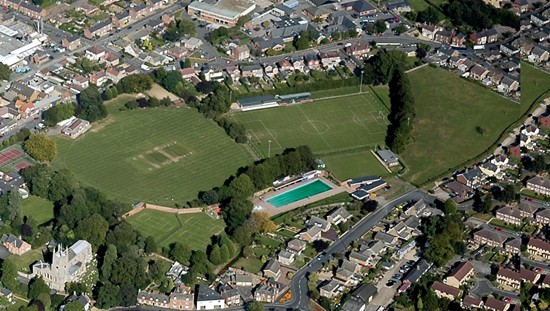 |
|
An aerial view of the Abbey Lawn
showing the cricket ground to the left, the football pitch, tennis
courts, the outdoor swimming pool and bowls club. |
|
 |
|
The clubhouse of Bourne Town Bowls Club |
|
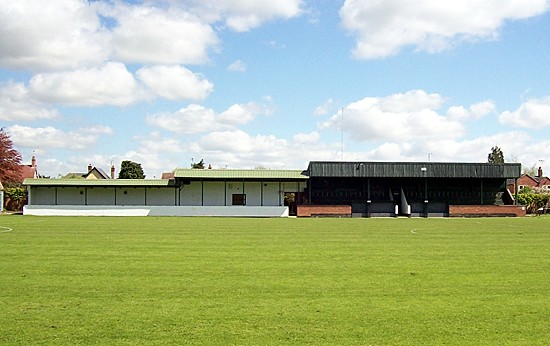 |
|
The football stadium
(above) and cricket club headquarters (below), opened on
3rd
August 1966 after the previous premises were destroyed by fire. |
|
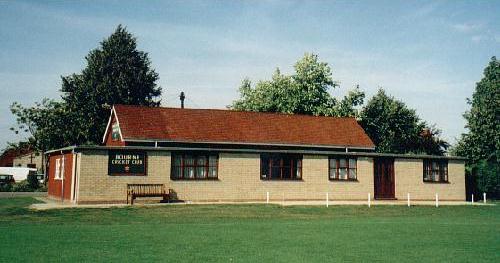 |
|
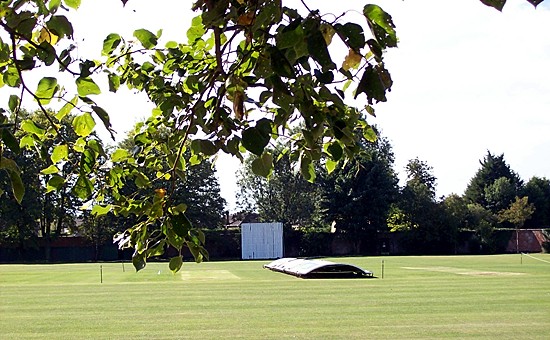 |
|
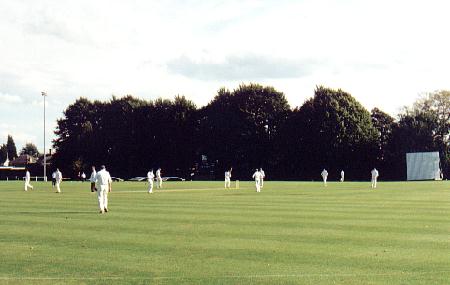 |
|
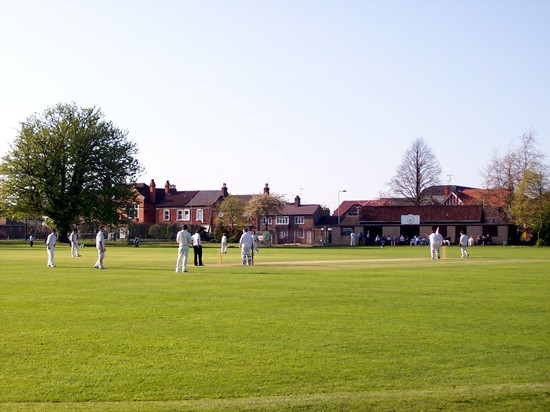
|
|
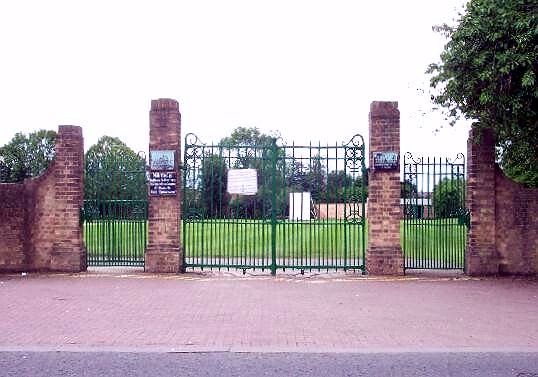 |
|
The handsome
hand-forged, wrought iron entrance gates to the Abbey Lawn were
made during the 18th century and formerly graced an estate
entrance to a stately home in Derbyshire. They were acquired and
installed in 1933 by the trustees of Bourne United Charities and
the side gates were made to match by William Friend, an
agricultural engineer and specialist in metal work who was in
business in Bourne at that time.
In 2008, a structural survey by Bourne United Charities revealed
that the gates and their supports were deteriorating and ordered a
refurbishment programme that included the erection of new brick
pillars while the gates were strengthened and repaired,
shot-blasted and re-painted. Work was completed the following year
and the gates were back in use by May 2009. |
|
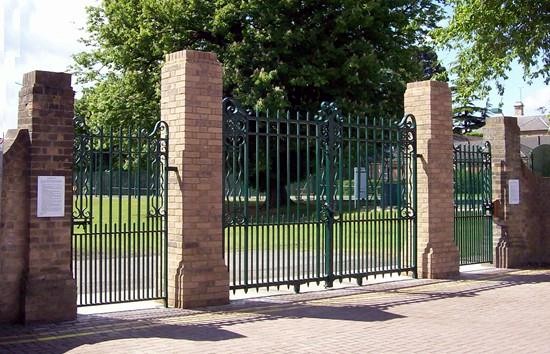 |
|
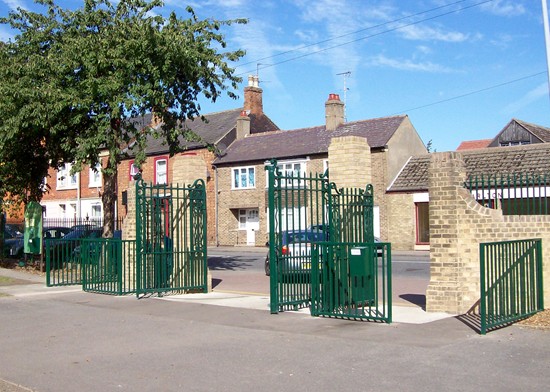 |
|
The plaques on the central pillars which had
begun to deteriorate were also restored. |
|
 |
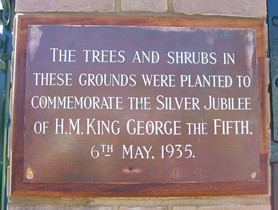 |
|
FROM THE ARCHIVES |
|
EVANGELISATION SOCIETY: Mr Arthur Cook, who
has been the evangelist in charge of the Society's tent on the
Abbey Lawn for the past fortnight, gave his concluding service on
Wednesday evening. The congregations, which at first were large,
have recently fallen off. Mr Cook takes charge of a neighbouring
district and Mr Smith succeeds him at Bourne. - news item from
the Grantham Journal, Saturday 18th August 1888. PICTURESQUE AVENUE OF ELMS
FELLED: One of the most attractive
features of the Abbey Lawn during the 19th century was an avenue
of elm trees along the northern boundary with Star Lane, now Abbey
Road. The trees were interspersed with a number of stone cairns,
built with materials that may have come either from the Abbey
House when it was demolished in 1879 or even from the old abbey
itself. But the trees were felled after complaints that they were
becoming a health hazard despite widespread protests that their
disappearance would ruin the appearance of the area and there was
also a feeling that the trees were being removed for gain rather
than to ensure public safety.
The widespread disquiet in the town was voiced by the local
correspondent of the Stamford Mercury, then J J Davies,
headmaster of the Boys' Council or Board School, now the Abbey Road Primary
School. On 28th December 1891, he wrote: "The threatened destruction or
spoliation of the splendid avenue of ancient elms which, forming
the northern boundary of the Abbey Lawn, renders the scenery so
picturesque, must be averted. A rumour is current that several of
these fine trees have been earmarked, and their cubic dimensions
calculated, with a view to their sale. The reason alleged for the
destruction of the trees is said to be that, by shading the entire
length of the Star Lane, they render it damp. Instead of removing
the trees, what is required is that a proper footpath should be
made beneath the trees with a gully for drainage."
The protests fell on deaf ears and the trees were cut down. J J
Davies reported in the Stamford Mercury on 1st January
1892: "My protest against the demolition of the fine avenue
of elms bordering the Abbey Lawn has had no effect. The trees are
being merrily felled. Picturesqueness has been sacrificed to
profit. The cottages opposite will now be favoured with a better
view of the railway line and the stone cairns saved from temporary
destruction. It would have been a pity to have removed these for
the sake of a few old trees. At the same time, it is a still
greater pity that a few picturesque features still remaining to
redeem the miserable monotony of the fens cannot be preserved. I
suppose there will still be an outcry that the tower of the Abbey
Church blocks the light from some stable window. If the complaint
is made, one thing is pretty certain: the stable must remain
intact."
The eventual fate of the cairns is not known for certain but many
such stones survive in Bourne, some in Baldock's Mill, some in the
grounds of Bourne House in West Street where they have been
converted into seats, and others in private gardens around the
town. |
|
PHOTO ALBUM |
|
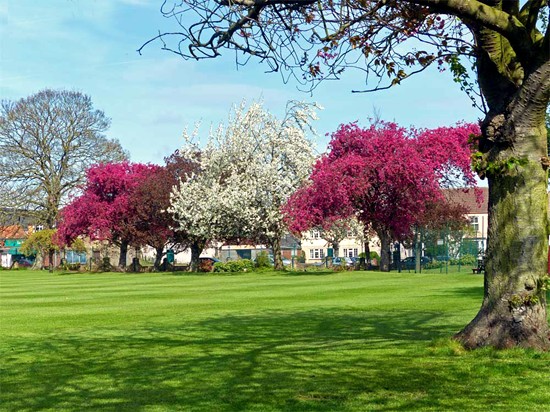 |
|
The Abbey Lawn in spring is a delight for
walkers and lovers of sport because the ground staff are usually
busy around this time preparing the wicket for the forthcoming
cricket season (below). |
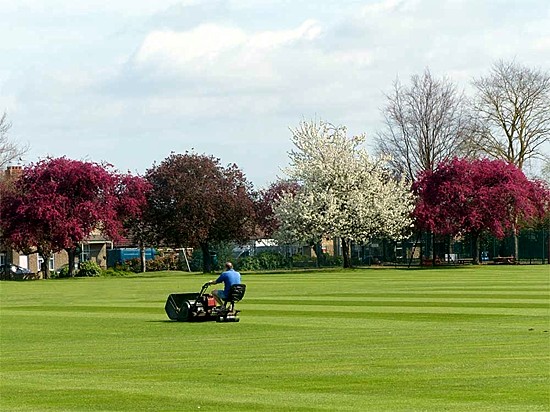 |
REVISED JUNE 2017
See also
The YMCA hut Security at the Abbey Lawn
The Horace
Stanton Memorial Garden
The Abbey Lawn in Past Times
Skatepark will
ruin the Abbey Lawn, claim conservationists

Go to:
Main Index Villages
Index
|















